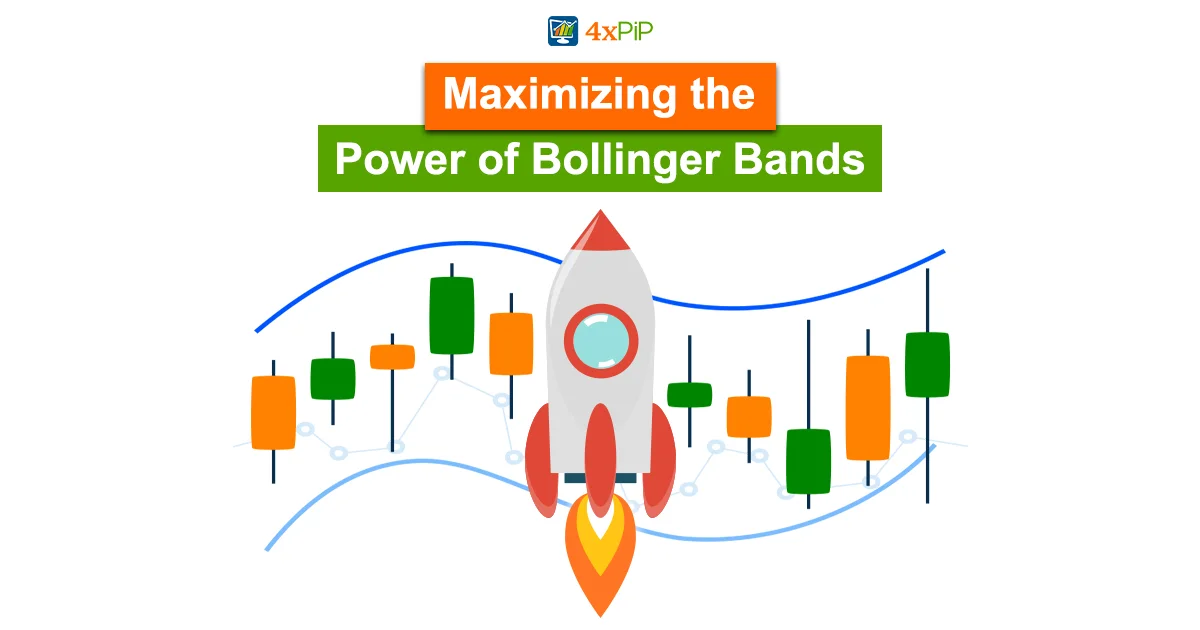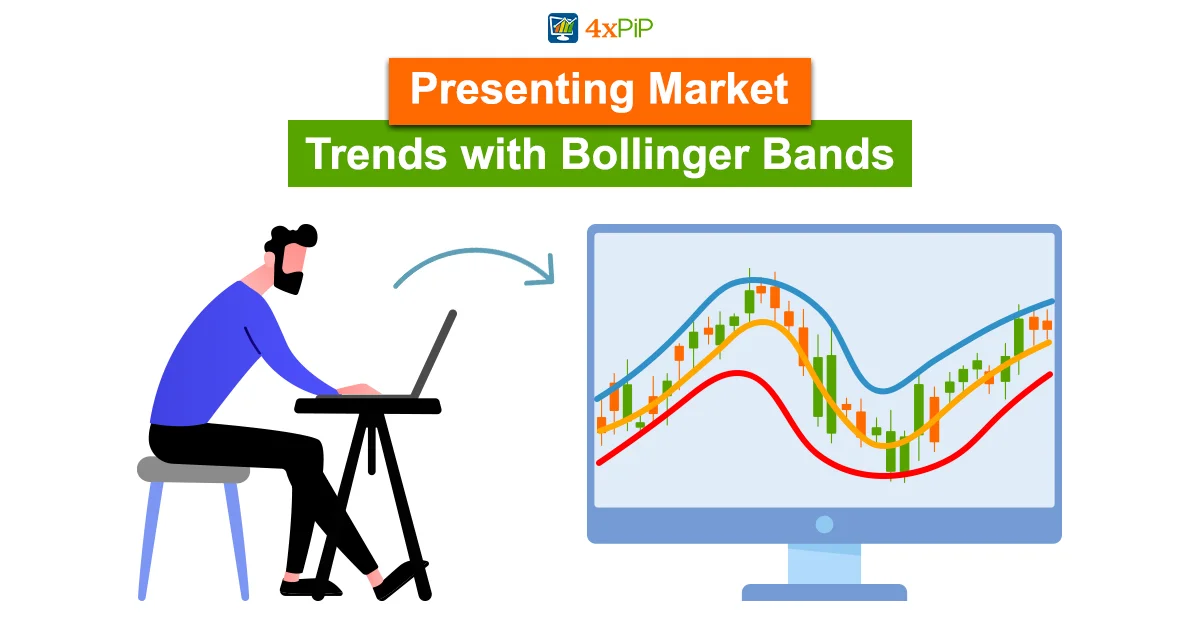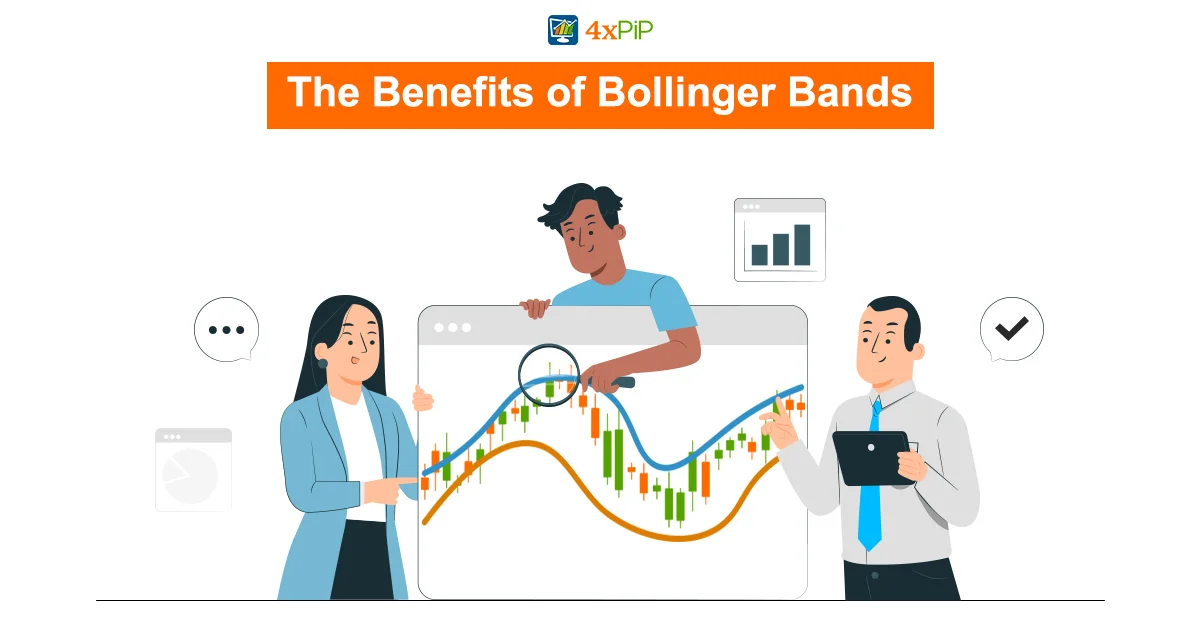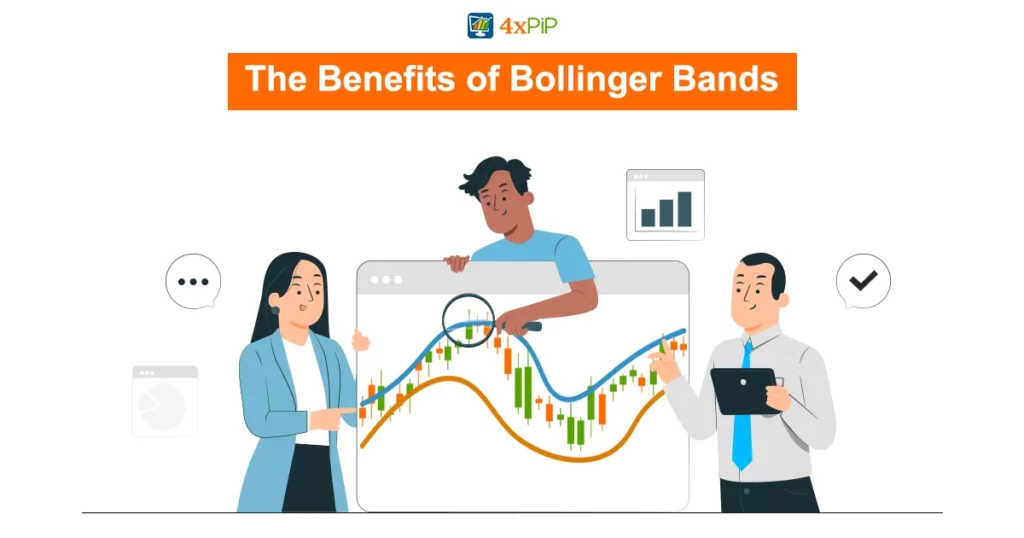Developed by John Bollinger, These bands act like flexible boundaries that adjust to the market’s ups and downs. Traders use them to find good times to start and stop trading, making them helpful for both new and experienced traders. Learn more about Bollinger Bands and improve your trading strategies by getting advice from 4xPip’s experts and explore our tools for trading like MT4 EA Bollinger Band and MT5 EA Bollinger Band. If you have questions, contact our customer support at [email protected] for help.
Maximizing the Power of Bollinger Bands:

Bollinger Bands are a useful tool for traders. Their lines plotted above and below a 20-period average, showing the middle trend. These lines change position based on how much the market is moving. Placed at 2 times the average movement, they help see possible extreme prices. Knowing the stats – 1σ is 68%, 2σ is 95%, 3σ is 99% – helps analyze the market over different periods..
Traders use Bollinger Bands to look for important signals that guide their decisions. A buy trade is typically considered when the price touches or drops below the lower band, suggesting potential overselling and a buying opportunity, especially in a trending market. Conversely, a sell trade might be considered when the price touches or surpasses the upper band, indicating potential overbuying. Traders can use these signals to make informed decisions and improve their entry points.
Managing risks is essential in trading, and Bollinger Bands help in setting appropriate levels for stop-loss and take-profit orders. Placing a stop-loss just beyond the bands can guard against unexpected market reversals. Take-profit levels can be set when the price approaches the opposite band, suggesting a potential reversal or slowing momentum. Determining the lot size is also crucial, based on the trader’s risk tolerance and the distance between the bands. This strategic approach helps traders make calculated decisions, minimizing potential losses and maximizing profits. Knowing how to use Bollinger Bands can significantly improve a trader’s decision-making. For extra guidance, traders can check out 4xPip’s offers expert advice and trading tools like MT4 EA Bollinger Band and MT5 EA Bollinger Band ensuring traders have the necessary resources to navigate the markets effectively.
Managing Market Trends with Bollinger Bands:

Traders use Bollinger Bands to better understand market trends. John Bollinger created them, and they consist of a middle line (simple moving average) and two outer bands based on market volatility. Traders can manage and keep an eye out for market trends with the help of Bollinger bands
Traders use Bollinger Bands to find buy and sell signals. Buying is considered when the price touches or goes below the lower band, suggesting the market might be oversold. Selling is considered when the price touches or goes above the upper band, indicating a potential overbought market. This strategy helps traders make the most of market changes, especially during trending times.
Managing risk is key in trading, and Bollinger Bands can help with that too. Traders can use them to decide when to enter and exit trades. When setting stop-loss, take-profit, and lot size, the bands help gauge market volatility. In high volatility, it may be smart to widen stop-loss and take-profit margins, and adjust lot sizes to manage risk. Traders should adjust their strategy based on the specific characteristics of the market they are in.
Using Bollinger Bands for Risk Management:
Bollinger Bands, is a popular technical analysis tool which can provide valuable insights on market like market volatility, incoming trends, overbought and oversold conditions and trend strength. These bands consist of a simple moving average (SMA) surrounded by an upper and lower band, representing standard deviations from the SMA. They serve as dynamic indicators, adapting to market volatility. Understanding how to leverage Bollinger Bands for risk management is essential for any trader.
Before diving into risk management, it’s important to get a hold on the basic concept of Bollinger Bands. The bands expand and contract based on market volatility. In times of high volatility, the bands widen, and during calmer market conditions, they narrow. The upper and lower bands act as dynamic support and resistance levels, helping traders identify potential reversal points or breakouts.
One of the key utilities of Bollinger Bands is identifying best entry points for trades. A buy trade is often considered when the price touches or falls below the lower band, signaling potential devaluation. Oppositely, a sell trade might be considered when the price touches or rises above the upper band, indicating possible overvaluation. However, Traders should also look for confirmation from other indicators or price action to strengthen their decisions.
Now, let’s talk about managing risks. Bollinger Bands can help traders figure out where to set stop-loss levels. Placing a stop-loss a bit beyond the outer bands helps protect against sudden market changes. To secure profits during good times, set take-profit levels when the price touches the opposite band. Also, adjusting how much you’re trading based on the band width and overall market conditions helps match your trade size with how much the market is moving. For extra guidance, traders can check out 4xPip’s offers expert advice and trading tools like MT4 EA Bollinger Band and MT5 EA Bollinger Band ensuring traders have the necessary resources to navigate the markets effectively.
MT4 EA Bollinger Band:
MT5 EA Bollinger Band:
Bollinger Bands as a Shield Against Losses:
Bollinger Bands, additionally, are a handy tool for risk management in trading. They are like flexible lines above and below an average market price. These lines change based on how wild or calm the market is.
Imagine the market is like a rollercoaster. When it’s going up (bullish), it might be smart to buy when the price touches the lower band, suggesting it could go higher. On the other hand, when it’s going down (bearish), selling when the price hits the upper band might make sense.
One of the noteworthy aspects of Bollinger Bands is their ability to act as a guide for setting stop loss and take profit levels. When the price hits the upper band, it might be a signal for traders to set a stop loss order, reducing potential losses. Similarly, when the price touches the lower band, a strategic placement of take-profit orders could capture gains before the trend reverses. The beauty of Bollinger Bands lies in their flexibility to different trading styles, making them suitable for day trading, swing trading, and long-term investing.
Using Bollinger Bands in your trading plan is a smart move because they give a clear picture of how active or calm the market is, guiding you on when to get in or out. Combine them with other tools, and you’ve got a powerful way to manage risks.
Bollinger Bands and RSI Strategy:
Pairing Bollinger Bands with the Relative Strength Index (RSI) enhances the precision of your trading decisions. RSI, a momentum oscillator, measures the speed and change of price movements. It operates on a scale of 0 to 100, identifying overbought and oversold conditions. When these two indicators align, presenting a merging of signals, traders often witness optimal entry and exit points. For example, a buy trade might be opportune when the price touches the lower Bollinger Band, and the RSI hovers around 30, indicating potential devaluation. Conversely, when the price hits the upper Bollinger Band accompanied by an RSI reading near 70, suggesting overvaluation, traders could consider initiating a sell trade. In essence, these indicators offer valuable insights into market dynamics, guiding traders toward informed decision-making.
Managing risks is crucial in trading. Know when to use stop-loss, take-profit, and control lot sizes. In an uptrend, consider a buy trade, and in a downtrend, go for a sell trade. Set stop-loss orders below the lower Bollinger Band for buys and above the upper band for sells. Determine take-profit levels by looking at past price movements and spotting support and resistance. When it comes to lot size, use a percentage of your trading capital to keep risks low. Balancing these factors ensures a well-thought-out and disciplined trading strategy.
Summary:
Maximize your trading potential with Bollinger Bands, a versatile tool aiding in identifying market trends and managing risks. Developed by John Bollinger, these bands offer dynamic boundaries reflecting market volatility, assisting traders in determining optimal entry and exit points. Utilize 4xPip’s expert advice and trading tools like MT4 EA Bollinger Band and MT5 EA Bollinger Band to refine your strategies and navigate markets effectively. For inquiries, contact our customer support at [email protected]
FAQs
What are Bollinger Bands?
Bollinger Bands are dynamic indicators consisting of a simple moving average surrounded by upper and lower bands representing standard deviations from the average, aiding in understanding market volatility and trend strength.
How do traders use Bollinger Bands?
Traders use Bollinger Bands to identify buy and sell signals, with buying opportunities when prices touch or dip below the lower band and selling opportunities when prices touch or exceed the upper band.
What role do Bollinger Bands play in risk management?**
Bollinger Bands help traders set appropriate stop-loss and take-profit levels, with stop-loss orders typically placed beyond the bands to guard against unexpected market reversals.
How can Bollinger Bands assist in determining lot sizes?
Traders can adjust their lot sizes based on the distance between the bands and their risk tolerance, ensuring a strategic approach to risk management.
What is the significance of combining Bollinger Bands with the Relative Strength Index (RSI)?
Pairing Bollinger Bands with RSI enhances trading precision by identifying optimal entry and exit points, leveraging both indicators’ insights into market momentum and overbought/oversold conditions.
How do traders balance risks in different market conditions using Bollinger Bands?
Traders adjust their trading strategies based on market trends, setting stop-loss orders below the lower band in uptrends and above the upper band in downtrends to mitigate risks.
Can Bollinger Bands be utilized for various trading styles?
Bollinger Bands suit various trading styles—day, swing, and long-term. They’re flexible, adapting to different preferences and styles.
How do Bollinger Bands guide traders in setting take-profit levels?
Traders consider past prices and support/resistance levels to set take-profit levels, capitalizing on potential market reversals indicated by bands.
What is the importance of confirming Bollinger Bands signals with other indicators?
Bollinger Bands, when confirmed by other indicators or price action, enhance trading decisions by providing extra validation for trades.
How can traders enhance their trading strategies with 4xPip’s expert advice and trading tools?
By leveraging the expertise and tools offered by 4xPip, traders can refine their strategies, optimize their trading performance, and navigate markets with confidence. For further assistance, contact our customer support at [email protected]












